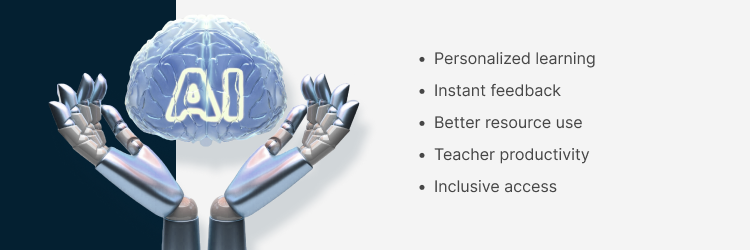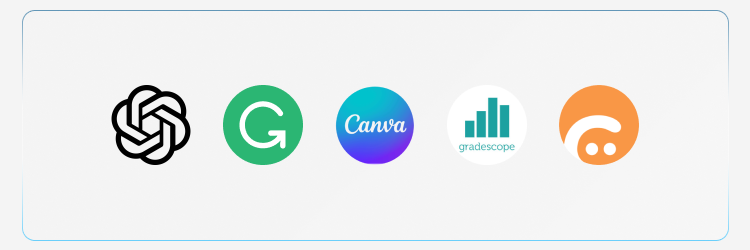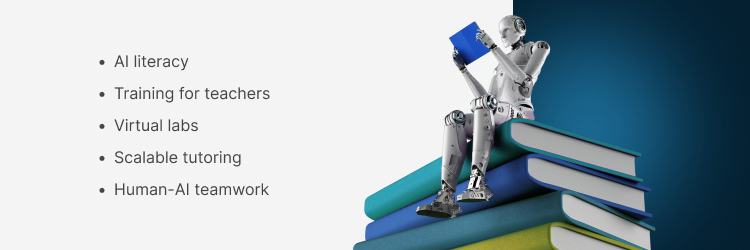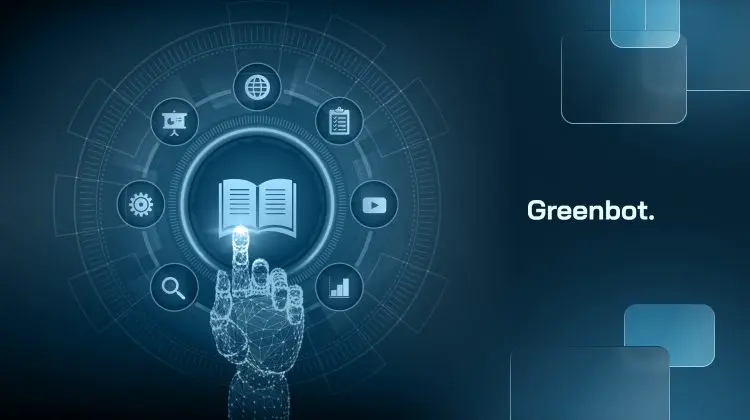
AI in education is already changing classrooms. It’s helping students learn at their own pace and freeing teachers from repetitive tasks. From smart grading to custom lesson plans, AI tools are making schools faster, smarter, and more inclusive.
Tools like ChatGPT now write quizzes, answer questions, and give on-demand tutoring. Artificial intelligence in education is no longer a buzzword—it’s shaping how we teach, learn, and connect across the entire education sector.
What Is AI in Education?
AI in education refers to the use of artificial intelligence systems to support learning and school operations. These tools analyze data and adjust instruction to meet each student’s individual needs.
AI technology encompasses machine learning, which tracks patterns in how students interact with content, and natural language processing, which enables systems to understand and respond to questions in real-time.
Adaptive learning tools adjust difficulty levels, keeping students engaged without feeling overwhelmed or bored.
How AI Is Being Used in Education Today
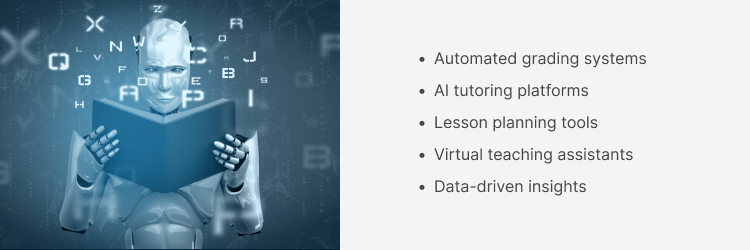
Most schools already utilize AI tools to enhance learning and streamline workloads. Over 90% of institutions rely on them in some way, with many focused on personalized learning and automated grading.
Platforms like Gradescope and Grade speed up feedback with AI-powered tools. Together, they serve over 1.5 million users.
Here’s how AI in education is being applied today:
- Automated grading systems that assess quizzes, essays, and code
- AI tutoring platforms that offer one-on-one support
- Lesson planning tools that generate content by curriculum
- Virtual teaching assistants that help during and after class
- Data-driven insights that help teachers spot learning gaps
Benefits of Artificial Intelligence in Education
AI is changing how students learn and how schools operate. Here are its top benefits:
- Personalized learning: AI adapts lessons to each student’s pace and style using adaptive platforms.
- Instant feedback: Students identify mistakes quickly with auto-graded quizzes and real-time feedback.
- Better resource use: AI helps with scheduling, tracking performance, and lesson planning.
- Teacher productivity: Teachers save time on grading and admin tasks.
- Inclusive access: Tools support learners with disabilities and those who face language barriers.
Pros and Cons of AI in Education
There’s no doubt about AI possibilities in learning environments, but it also comes with some drawbacks:
Pros
- Automates grading and scheduling
- Personalized learning paths
- 24/7 student support
- Smart insights for teachers
Cons
- High setup and maintenance costs
- Some schools lack the needed infrastructure
- Raises concerns over student data privacy
- Makes cheating and plagiarism easier
Empowering Educators with AI Tools
AI enables teachers to plan smarter, teach more effectively, and work more efficiently. They use tools to generate lessons, manage attendance, and grade more efficiently.
Instead of being overwhelmed by paperwork, educators can focus on creativity and student progress. AI also helps spot gaps in learning and fine-tune teaching strategies.
Improving Educational Outcomes Through AI
AI helps track student progress and give real-time feedback. Teachers use these insights to adjust their approach and provide better support to students.
Platforms like Gradescope simplify assessments. This frees teachers to focus more on engagement rather than logistics. In the long run, AI boosts both student success and educator efficiency.
AI Tools Every Educator Should Know
Educators today can leverage AI tools to improve instruction, save time, and enrich the learning experience. These AI systems help explain complex concepts, generate instructional content, and provide detailed feedback to boost academic performance.
- ChatGPT: Ideal for planning lessons, simplifying complex concepts, and generating quizzes. It’s also great for student responses and content creation at each learner’s own pace.
- Grammarly: Acts as a writing assistant. Helps edit documents, prepare assignments, and ensure clear communication. It’s one of the best assessment tools for written work.
- Canva: Offers design tools for creating fast visuals, such as worksheets and slides. Great for creating interactive tools and instructional content without design experience.
- Gradescope: Streamlines grading. Teachers can automate grading, analyze performance, and deliver detailed feedback to improve academic performance.
- Curipod: Builds interactive tools and aligns with lesson standards. Helps with lesson planning, student engagement, and generative AI content tailored to classroom goals.
These tools help teachers streamline administrative tasks and enhance content delivery. They also develop effective intelligent tutoring systems that support every student’s ability to complete assignments with confidence.
>>> Check our ChatGPT review here.
The Role of Generative AI in Lesson Creation
Generative AI helps teachers create lesson content in less time. It can create quizzes, explainers, and visuals tailored to meet student needs.
Tools like ChatGPT and Canva Magic Write are excellent for creating quick and engaging materials. Teachers can spend more time teaching, not formatting slides.
The Future of AI in Education
AI is reshaping classrooms and learning culture. Here are trends to watch:
- AI literacy: Teaching students how to use and question AI tools.
- Training for teachers: Helping them spot gaps and improve lessons.
- Virtual labs: Offering hands-on practice without expensive gear.
- Scalable tutoring: Bringing one-on-one help to more students.
- Human-AI teamwork: Teachers and AI building better learning experiences together.
Ethical Considerations and Challenges
AI in schools brings real concerns. One is privacy—student data can be exposed if platforms aren’t secure. Another is bias in AI. If a system is trained on flawed data, it can unfairly judge students.
Academic integrity is also at risk. AI makes cheating easier, particularly with the use of generated content. Then there’s equitable access. Some schools simply cannot afford advanced tools or lack internet access.
These ethical considerations should guide how we use AI. Schools need strong policies to protect students and promote the fair and smart use of technology.
How AI Can Improve Critical Thinking and Creativity
AI can sharpen how students think. It pushes them to ask better questions, test answers, and explore new angles. That’s how critical thinking grows.
With AI feedback, students learn to revise and improve ideas. It helps them become better problem-solvers and more creative thinkers, not just answer seekers.
How AI Is Shaping the Future Workforce
AI is helping students develop skills they will need. AI literacy, coding, communication, and analysis are all in focus now.
The education sector is training students for future jobs by making student learning more relevant. AI prepares them to adapt, create, and lead in tech-driven fields.
AI in Modern Classrooms
In today’s classrooms, AI is everywhere. Smartboards and interactive tools keep lessons lively. Educational games turn learning into play.
AI technology also supports modern education through adaptive platforms and real-time feedback. This keeps students engaged and teachers informed.
What Educators Need to Know Before Integrating AI
Before jumping in, teachers should ask:
- Does this tool collect personal data, and is it secure?
- Has it been tested for bias to ensure fair use?
- Can I control the level of AI involvement?
Informed decisions matter. The goal is to empower educators while maintaining ethical considerations. Let AI support teaching, not replace it.
Frequently Asked Questions About AI in Education
How is AI being used in education?
AI supports student learning through personalized lessons, immediate feedback, and automated grading. Teachers use it for planning and tutoring. It boosts teachers’ time, streamlines tasks, and helps students learn at their own pace.
What are the ethical concerns with AI in schools?
Top issues include the use of AI by students for cheating, concerns about privacy, and the potential for bias in AI. Some tools may misuse data or assess unfairly. Ensuring accessibility and fairness is key to reducing the potential drawbacks.
Will AI replace teachers?
No. AI assists by automating administrative tasks and giving detailed feedback, but it can’t replace real teaching. Teachers provide context, support, and creativity—things AI can’t fully replicate in the education sector.
What tools are educators using?
Teachers leverage AI tools like ChatGPT for planning, Curipod for content, and Gradescope for assessments. These tools help provide students with faster feedback, support academic performance, and simplify complex tasks in modern education.
Final Thoughts on Artificial Intelligence in Education
AI in education isn’t just hype—it’s helping real people in real classrooms. When used right, it can empower educators, boost student learning, and make school feel less like a grind.
It’s not about replacing teachers. It’s about giving them tools that work smarter, not harder. So yeah, let AI handle the boring stuff. Let humans keep the heart of teaching.
If we keep it fair, ethical, and accessible? Artificial intelligence in education could make learning fun, inclusive, and way more effective. Let’s not screw it up.
